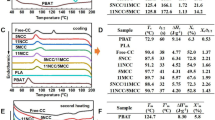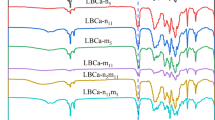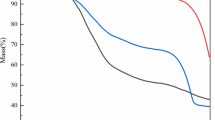Abstract
The purpose of this study is to investigate the use of nucleating agent to improve the overall performance of polybutylene adipate-co-terephthalate (PBAT) and calcium carbonate (CaCO3) composites. Specifically, sodium linoleate (Na-LL) is used as a chemical nucleating agent to improve the crystallization behavior of the material during melting extrusion processing. Mechanical, thermal, and morphological characteristics of PBAT and its composites were investigated. And a preliminary exploration was conducted on the mechanism of Na-LL improving the performance of PBAT. In this work, a formula has been obtained that dramatically saves production costs while improving product performance. After adding Na-LL to the composites, the thermal properties of the material were significantly improved, with a maximum crystallization temperature increase of 27.79 °C. In addition, composites offer superior mechanical properties compared to pure PBAT. When 0.2 parts by mass(pbw) Na-LL was added, the flexural modulus of the composites increased from 80.0 to 145.3 MPa, increased by 81.25%. The tensile performance can still be maintained at 11.0 Mpa, with elongation at break and impact strength reduced to 347.3% and 172.1 J/m, respectively. Under these conditions, it has excellent comprehensive mechanical properties. The results in this study suggest that Na-LL is a promising nucleating agent for enhancing the performance of composites and provides potential development of advanced materials for a wide range of applications in plastic packaging and plastic bags.





Similar content being viewed by others
References
Verdi AG, De Souza AG, Rocha DB, De Oliveira SA, Alves RMV, Dos Santos RD. Biodegradable films functionalized with Moringa oleifera applied in food packaging. Iran Polym J. 2020;30(3):235–46.
Yang Y, Zhang C, Weng Y. Effects of CaCO3 surface modification and water spraying on the weathering properties of PBAT/CaCO3 films. Polym Test. 2021;102:107334.
Iwata T. Biodegradable and bio-based polymers: future prospects of eco-friendly plastics. Angew Chem Int Ed. 2015;54(11):3210–5.
Rai P, Mehrotra S, Priya S, Gnansounou E, Sharma SK. Recent advances in the sustainable design and applications of biodegradable polymers. Bioresour Technol. 2021;325:124739.
Ebrahimi F, Ramezani DH. Poly lactic acid (PLA) polymers: from properties to biomedical applications. Int J Polym Mater Polym Biomater. 2021;71(15):1117–30.
Sehgal R, Gupta R. Polyhydroxyalkanoate and its efficient production: an eco-friendly approach towards development. 3 Biotech. 2020;10(12):549.
Zhang J, Shishatskaya EI, Volova TG, da Silva LF, Chen GQ. Polyhydroxyalkanoates (PHA) for therapeutic applications. Mater Sci Eng C. 2018;86:144–50.
Kantor-Malujdy N, Skowron S, Michalkiewicz B, El Fray M. Poly (butylene-succinate)-based blends with enhanced oxygen permeability. Mater Today Commun. 2022;33:104306.
Witt U, Yamamoto M, Seeliger U, Müller R-J, Warzelhan V. Biodegradable polymeric materials—Not the origin but the chemical structure determines biodegradability. Angew Chem Int Ed. 1999;38(10):1438–42.
Liu J, Wang P, Wang Y, Zhang Y, Xu T, Zhang Y, Xi J, Hou L, Li L, Zhang Z, Lin Y. Negative effects of poly (butylene adipate-co-terephthalate) microplastics on Arabidopsis and its root-associated microbiome. J Hazard Mater. 2022;437:129294.
Yang F, Chen G, Li J, Zhang C, Ma Z, Zhao M, Yang Y, Han Y, Huang Z, Weng Y. Effects of quercetin and organically modified montmorillonite on the properties of poly(butylene adipate-co-terephthalate)/thermoplastic starch active packaging films. ACS Omega. 2023;8(1):663–72.
Olivato J, Grossmann M, Yamashita F, Eiras D, Pessan L. Citric acid and maleic anhydride as compatibilizers in starch/poly (butylene adipate-co-terephthalate) blends by one-step reactive extrusion. Carbohyd Polym. 2012;87(4):2614–8.
Garcia PS, Grossmann MV, Shirai MA, Lazaretti MM, Yamashita F, Muller CM, Mali S. Improving action of citric acid as compatibiliser in starch/polyester blown films. Indus Crops Products. 2014;52:305–12.
Kim JH, Lee JC, Kim GH. Study on poly (butylene adipate-co-terephthalate)/starch composites with polymeric methylenediphenyl diisocyanate. J Appl Polym Sci. 2015;132(16):41884.
Wei D, Wang H, Xiao H, Zheng A, Yang Y. Morphology and mechanical properties of poly (butylene adipate-co-terephthalate)/potato starch blends in the presence of synthesized reactive compatibilizer or modified poly (butylene adipate-co-terephthalate). Carbohydrate Polym. 2015;123:275–82.
Moustafa H, Guizani C, Dufresne A. Sustainable biodegradable coffee grounds filler and its effect on the hydrophobicity, mechanical and thermal properties of biodegradable PBAT composites. J Appl Polym Sci 2017; 134(8):44498
Garalde RA, Thipmanee R, Jariyasakoolroj P, Sane A. The effects of blend ratio and storage time on thermoplastic starch/poly(butylene adipate-co-terephthalate) films. Heliyon. 2019;5(3):e01251.
Xiong S-J, Pang B, Zhou S-J, Li M-K, Yang S, Wang Y-Y, Shi Q, Wang S-F, Yuan T-Q, Sun R-C. Economically competitive biodegradable PBAT/lignin composites: effect of lignin methylation and compatibilizer. ACS Sustain Chem Eng. 2020;8(13):5338–46.
Zhai X, Wang W, Zhang H, Dai Y, Dong H, Hou H. Effects of high starch content on the physicochemical properties of starch/PBAT nanocomposite films prepared by extrusion blowing. Carbohydrate Polym. 2020;239:116231.
Liu Y, Liu S, Liu Z, Lei Y, Jiang S, Zhang K, Yan W, Qin J, He M, Qin S, Yu J. Enhanced mechanical and biodegradable properties of PBAT/lignin composites via silane grafting and reactive extrusion. Compos Part B: Eng. 2021;220:108980.
Li W, Huang J, Liu W, Qiu X, Lou H, Zheng L. Lignin modified PBAT composites with enhanced strength based on interfacial dynamic bonds. J Appl Polym Sci. 2022;139(27):e52476.
Xie L, Huang J, Xu H, Feng C, Na H, Liu F, Xue L, Zhu J. Effect of large sized reed fillers on properties and degradability of PBAT composites. Polym Compos. 2023;44(3):1752–61.
Wang XW, Wang GX, Huang D, Lu B, Zhen ZC, Ding Y, Ren ZL, Wang PL, Zhang W, Ji JH. Degradability comparison of poly (butylene adipate terephthalate) and its composites filled with starch and calcium carbonate in different aquatic environments. J Appl Polym Sci. 2019;136(2):46916.
Nunes EDC, De Souza AG, Rosa DDS. Use of a chain extender as a dispersing agent of the CaCO3 into PBAT matrix. J Compos Mater. 2020;54(10):1373–82.
Titone V, La Mantia FP, Mistretta MC. The effect of calcium carbonate on the photo-oxidative behavior of poly (butylene adipate-co-terephthalate). Macromol Mater Eng. 2020;305(10):2000358.
Zhang T, Zhang C, Yang Y, Yang F, Zhao M, Weng Y. Improved properties of poly (butylene adipate-co-terephthalate)/calcium carbonate films through silane modification. J Appl Polym Sci. 2021;138(38):50970.
Rapisarda M, Mistretta MC, Scopelliti M, Leanza M, La Mantia FP, Rizzarelli P. Influence of calcium carbonate nanoparticles on the soil burial degradation of Polybutyleneadipate-Co-Butylenetherephthalate films. Nanomaterials. 2022;12(13):2275.
Jarapanyacheep R, Ruksakulpiwat Y, Jarukumjorn K. Melt processing of maleic anhydride grafted poly (lactic acid) and its compatibilizing effect on poly (lactic acid)/poly (butylene adipate-co-terephthalate) blend and their composite. Polym Sci Ser A. 2017;59:384–96.
Costa AR, Reul LT, Sousa FM, Ito EN, Carvalho LH, Canedo EL. Degradation during processing of vegetable fiber compounds based on PBAT/PHB blends. Polym Test. 2018;69:266–75.
Rocha DB, Souza De Carvalho J, De Oliveira SA, Dos Santos Rosa D. A new approach for flexible PBAT/PLA/CaCO3 films into agriculture. J Appl Polym Sci 2018; 135(35): 46660.
Balaji S, Venkatesan R, Mugeeth L, Dhamodharan R. Hydrophobic nanocomposites of PBAT with Cl-fn-POSS nanofiller as compostable food packaging films. Polym Eng Sci. 2021;61(1):314–26.
Pal AK, Wu F, Misra M, Mohanty AK. Reactive extrusion of sustainable PHBV/PBAT-based nanocomposite films with organically modified nanoclay for packaging applications: compression moulding vs cast film extrusion. Compos Part B: Eng. 2020;198:108141.
Zhao H, Liu H, Liu Y, Yang Y. Blends of poly (butylene adipate-co-terephthalate) (PBAT) and stereocomplex polylactide with improved rheological and mechanical properties. RSC Adv. 2020;10(18):10482–90.
Tian H-L, Wang Z-P, Jia S-L, Pan H-W, Han L-J, Bian J-J, Li Y, Yang H-L, Zhang H-L. Biodegradable foaming material of poly(butylene adipate-co-terephthalate) (PBAT)/Poly(propylene carbonate) (PPC). Chin J Polym Sci. 2021;40(2):208–19.
Wu D, Guo Y, Huang A, Xu R, Liu P. Effect of the multi-functional epoxides on the thermal, mechanical and rheological properties of poly (butylene adipate-co-terephthalate)/polylactide blends. Polym Bull. 2021;78(10):5567–91.
Shi N, Cai J, Dou Q. Crystallization, morphology and mechanical properties of PLA/PBAT/CaCO3 composites. Adv Mater Res. 2013;602:768–71.
Wongphan P, Nerín C, Harnkarnsujarit N. Enhanced compatibility and functionality of thermoplastic cassava starch blended PBAT blown films with erythorbate and nitrite. Food Chem. 2023;420:136107.
Fukushima K, Wu M-H, Bocchini S, Rasyida A, Yang M-C. PBAT based nanocomposites for medical and industrial applications. Mater Sci Eng, C. 2012;32(6):1331–51.
Wang Y, Liu Q, Zhen ZC, Liu JL, Qiao RM, He WQ. Effects of mica modification with ethylene-vinyl acetate wax on the water vapor barrier and mechanical properties of poly-(butylene adipate-co-terephthalate) nanocomposite films. J Appl Polym Sci. 2021;138(26):50610.
Huang WT, He GJ, Tang WD, Zou XL, Yin XC. A facile approach to realize simultaneously chain extension and crystallization promotion of poly (ethylene terephthalate). Polym Degrad Stab. 2021;190:109644.
Costa AR, Almeida TG, Silva SM, Carvalho LH, Canedo EL. Chain extension in poly (butylene-adipate-terephthalate). Inline testing in a laboratory internal mixer. Polym Test. 2015;42:115–21.
Gou J, Zhang L, Li C. A new method combining modification of montmorillonite and crystal regulation to enhance the mechanical properties of polypropylene. Polym Test. 2020;82:106236.
Nunes EDC, Souza AGD, Coiado RD, Moura EA, Rosa DDS. Evaluation of the poly (lactic acid) and calcium carbonate effects on the mechanical and morphological properties in PBAT blends and composites. Int J Innov Sci Eng Technol. 2017;4(6):313–8.
Liu Y, Wirasaputra A, Jiang Z, Liu S, Zhao J, Fu Y. Fabrication of improved overall properties of poly (ethylene terephthalate) by simultaneous chain extension and crystallization promotion. J Therm Anal Calorim. 2018;133(3):1447–54.
Pan H, Ju D, Zhao Y, Wang Z, Yang H, Zhang H, Dong L. Mechanical properties, hydrophobic properties and thermal stability of the biodegradable poly(butylene adipate-co-terephthalate)/maleated thermoplastic starch blown films. Fibers and Polymers. 2016;17(10):1540–9.
Chen RY, Zou W, Zhang HC, Zhang GZ, Yang ZT, Jin G, Qu JP. Thermal behavior, dynamic mechanical properties and rheological properties of poly (butylene succinate) composites filled with nanometer calcium carbonate. Polym Test. 2015;42:160–7.
Venkatesan R, Sivaprakash P, Kim I, Eldesoky GE, Kim S-C. Tannic acid as a crosslinking agent in poly (butylene adipate-co-terephthalate) composite films enhanced with carbon nanoparticles: processing, characterization, and antimicrobial activities for food packaging. J Environ Chem Eng. 2023;11(4):110194.
Sirisinha K, Somboon W. Melt characteristics, mechanical, and thermal properties of blown film from modified blends of poly (butylene adipate-co-terephthalate) and poly (lactide). J Appl Polym Sci. 2012;124(6):4986–92.
Acknowledgements
This work was financially supported by Natural Science Foundation of Changsha (No. kq2202184) and Hunan Provincial Science and Technology Department (No. 2021GK5007).
Author information
Authors and Affiliations
Contributions
SS was contributed to methodology, data curation, writing—original draft, visualization, investigation. ZL was contributed to writing—review and editing, visualization. YL was contributed to writing—original draft, investigation. YL was contributed to validation, supervision. J-RZ was contributed to supervision, writing—review and editing. JT was contributed to supervision, writing—review and editing. Y-FZ was contributed to project administration, funding acquisition, supervision, writing—review and editing, conceptualization.
Corresponding author
Additional information
Publisher's Note
Springer Nature remains neutral with regard to jurisdictional claims in published maps and institutional affiliations.
Rights and permissions
Springer Nature or its licensor (e.g. a society or other partner) holds exclusive rights to this article under a publishing agreement with the author(s) or other rightsholder(s); author self-archiving of the accepted manuscript version of this article is solely governed by the terms of such publishing agreement and applicable law.
About this article
Cite this article
Sheng, S., Li, Z., Li, Y. et al. Using sodium linoleate as a nucleating agent to improve the properties of PBAT/CaCO3 composites. J Therm Anal Calorim 148, 13859–13868 (2023). https://doi.org/10.1007/s10973-023-12584-5
Received:
Accepted:
Published:
Issue Date:
DOI: https://doi.org/10.1007/s10973-023-12584-5




